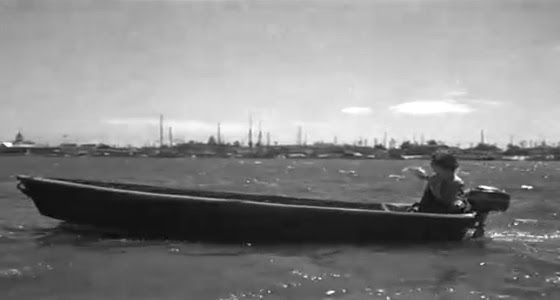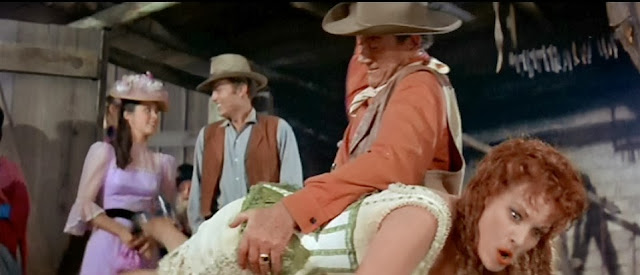Before Mannequin (1987), another inanimate simulation of a female form comes to life in the movie One Touch of Venus (1948).
The kiss from Eddie the department store clerk animates a statue of the Roman goddess of love. Unable to explain to his employer why the statue is missing and unable to explain the new woman in his life to his fiancee ruins Eddie's personal life and career.
Why the guy would kiss a statue is never explained. In the play, he slips an engagement ring on her finger, which still makes no sense but is somehow less creepy... no, actually it isn't.
Robert Walker (now known for the Hitchcock thriller Strangers on a Train (1951)) stars as the hen-pecked clerk in this comedy. This is the type of juvenile role from which the actor was desperate to escape since the beginning of his career.
Says Hollywood columnist Bob Thomas on March 5, 1946 about Walker's desire to mature on the screen,
And here he is two years later doing the very thing he detests.
Venus has a fun movie premise, but is executed as a sitcom. A very old sitcom. One where reaction shots consist of actors bugging out their eyes and committing to exaggerated double-takes.
Eddie and his fiancee Gloria (Olga San Juan) are especially fond of overacting. They are like live-action cartoons. They deserve each other.
On the other hand, you have Eddie's best friend Joe (Dick Haymes) who is a calming presence and never raises his voice above a hush. (Ah, that mellow crooner's sound.) He's the only sane one in the film and you don't get to see much of him.
He's also the only man in the movie who doesn't try to seduce the statue. For some unfathomable reason, he's too busy making time with his best friend's intended - Gloria.
Now we come to Venus herself, played by Ava Gardner. All she has to do is stand around and look pretty. But she gives great reaction shots.
The actress would turn 26 in the year of this film's release. By this time, she had appeared in over 26 feature films and shorts, mostly uncredited. Working not so completely in the spotlight for so many years would serve her well (at this point, she was better known as the former Mrs. Mickey Rooney and as Artie Shaw's ex). She would use the time to focus on her craft and change herself from the little girl from the country, into a megastar onscreen.
This is the face of experience.
The actress is probably best known now for her work with gritty tales like The Killers, Show Boat and Mogambo. Still, she shows in Venus that she can handle comedy well.
Even with that, she's probably still better-known for her personal life, particularly her choice of mates, including Frank Sinatra. Gardner was the "other woman" -the Angelina Jolie- of the affair and Nancy B. Sinatra was the beleaguered wife- the Jennifer Aniston- of the triangle.
You'll also note that Gardner often plays "the other woman" in movies, including in the film we're discussing today. In any case, this is a megastar in the making, complete with tragedies both and on- and off-screen.
You could do worse than watch this film.
The kiss from Eddie the department store clerk animates a statue of the Roman goddess of love. Unable to explain to his employer why the statue is missing and unable to explain the new woman in his life to his fiancee ruins Eddie's personal life and career.
Why the guy would kiss a statue is never explained. In the play, he slips an engagement ring on her finger, which still makes no sense but is somehow less creepy... no, actually it isn't.
Robert Walker (now known for the Hitchcock thriller Strangers on a Train (1951)) stars as the hen-pecked clerk in this comedy. This is the type of juvenile role from which the actor was desperate to escape since the beginning of his career.
Says Hollywood columnist Bob Thomas on March 5, 1946 about Walker's desire to mature on the screen,
" Robert Walker, a contentious character, says at last he is getting the chance to act.
'So far I have been playing naive boys,' he told me.... He contended he is neither a boy (he is 27), nor naive (he didn't explain this).
The Salt Lake City actor said his first chance to escape the gee-whiz type of role is in 'Till the Clouds Roll By,' the Jerome Kern biography....Walker is playing the late composer and he says it is a challenge to his acting ability."
And here he is two years later doing the very thing he detests.
Venus has a fun movie premise, but is executed as a sitcom. A very old sitcom. One where reaction shots consist of actors bugging out their eyes and committing to exaggerated double-takes.
Eddie and his fiancee Gloria (Olga San Juan) are especially fond of overacting. They are like live-action cartoons. They deserve each other.
On the other hand, you have Eddie's best friend Joe (Dick Haymes) who is a calming presence and never raises his voice above a hush. (Ah, that mellow crooner's sound.) He's the only sane one in the film and you don't get to see much of him.
He's also the only man in the movie who doesn't try to seduce the statue. For some unfathomable reason, he's too busy making time with his best friend's intended - Gloria.
Now we come to Venus herself, played by Ava Gardner. All she has to do is stand around and look pretty. But she gives great reaction shots.
The actress would turn 26 in the year of this film's release. By this time, she had appeared in over 26 feature films and shorts, mostly uncredited. Working not so completely in the spotlight for so many years would serve her well (at this point, she was better known as the former Mrs. Mickey Rooney and as Artie Shaw's ex). She would use the time to focus on her craft and change herself from the little girl from the country, into a megastar onscreen.
This is the face of experience.
The actress is probably best known now for her work with gritty tales like The Killers, Show Boat and Mogambo. Still, she shows in Venus that she can handle comedy well.
Even with that, she's probably still better-known for her personal life, particularly her choice of mates, including Frank Sinatra. Gardner was the "other woman" -the Angelina Jolie- of the affair and Nancy B. Sinatra was the beleaguered wife- the Jennifer Aniston- of the triangle.
You'll also note that Gardner often plays "the other woman" in movies, including in the film we're discussing today. In any case, this is a megastar in the making, complete with tragedies both and on- and off-screen.
You could do worse than watch this film.










+-+hope+barber.jpg)
+-+banquet.jpg)















































































